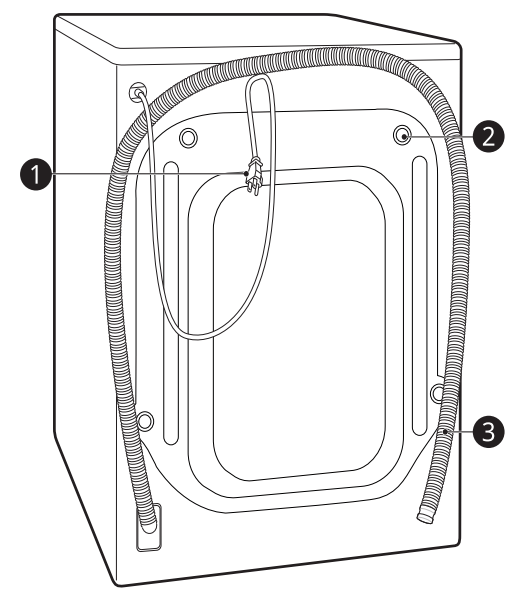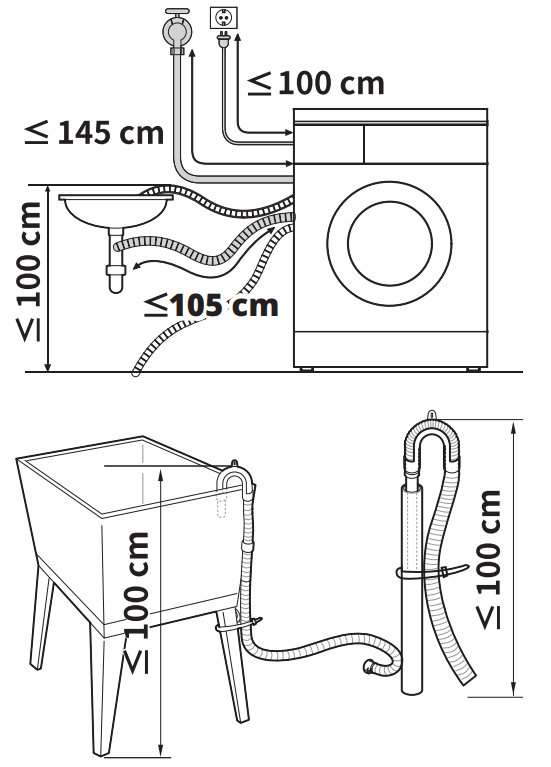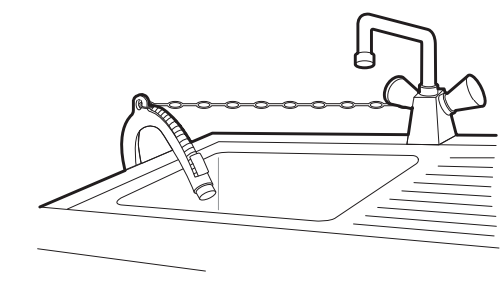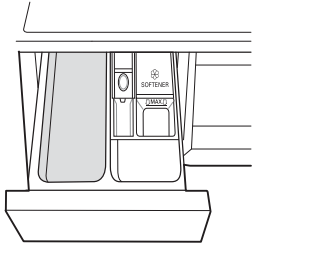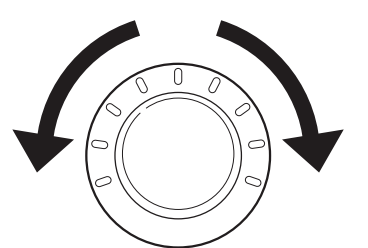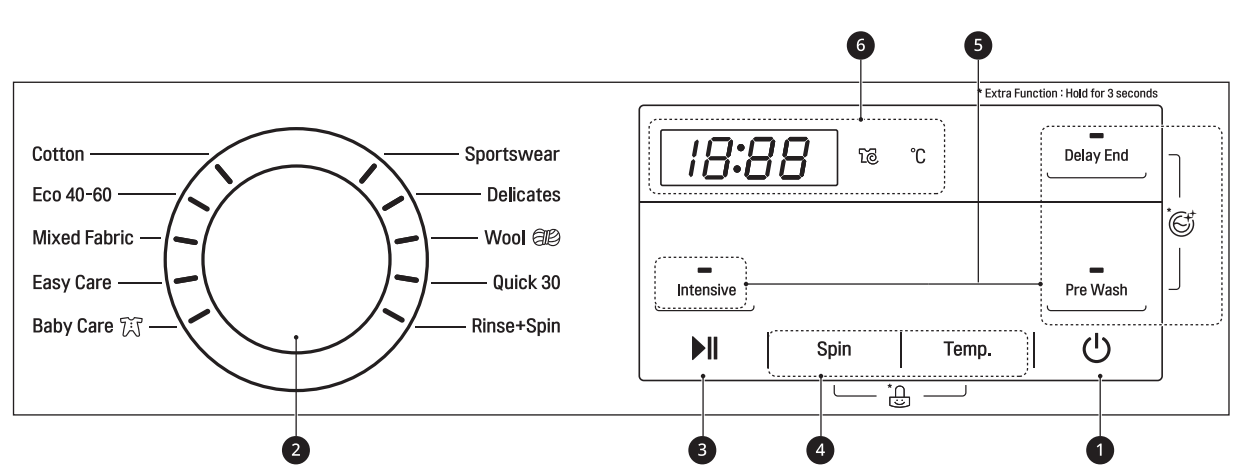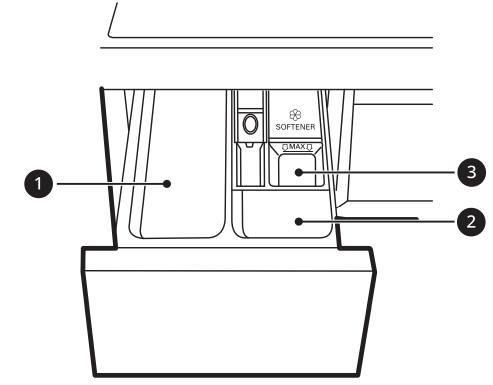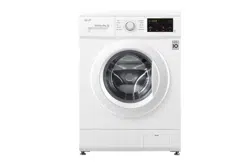Documents: Go to download!
- Owner's manual - (English)
- INSTALLATION
- OPERATION
- SMART FUNCTIONS
- MAINTENANCE
- TROUBLESHOOTING
Table of contents
OWNER'S MANUAL WASHING MACHINE
INSTALLATION
Parts and Specifications
|
|
|
|
|
Accessories


Installation Place Requirements
- This appliance must be installed on firm flooring to minimize vibration during the spin cycle. Concrete flooring is best, being far less prone to vibration during the spin cycle than wooden floorboards or a carpeted surface.
- If it is impossible to avoid positioning the appliance next to a gas cooker or coal burning stove, an insulation (850 X mm) covered with aluminum foil on the side facing the cooker or stove must be inserted between the two appliances.
- Ensure that when the appliance is installed, it is easily accessible for an engineer in the event of a breakdown.
- When installing the appliance, adjust all four feet using the transit bolt spanner provided to ensure the appliance is stable.
Floor Installation
To ensure sufficient clearance for water inlet hoses, drain hose and airflow, allow minimum clearances of at least 20 mm at the sides and 100 mm behind the appliance. Be sure to allow for wall, door,or floor moldings that may increase the required clearances.

WARNING: This appliance must only be used for domestic household purposes and should not be used in mobile applications.
NOTE: Never try to level any uneven floor by putting pieces of wood, cardboard or similar materials under the appliance.
Wooden Floors (Suspended Floors)
When installing the appliance on wooden floors, use rubber cups to reduce excessive vibration and unbalance. Timber or suspended type flooring may contribute to excessive vibration and unbalance, errors and malfunction.
- To reduce vibration, we recommend placing at least 15 mm thickness of rubber cups a under each adjusting foot of the appliance, secured to at least two floor beams with screws.
- If possible, install the appliance in one of the corners of the room, where the floor is more stable.
- Fit the rubber cups to reduce vibration.
Ventilation
Make sure that air circulation around the appliance should not be impeded by carpets, rugs, etc.
Ambient Temperature
- Do not install the appliance in rooms where freezing temperatures may occur. Frozen hoses may burst under pressure. The reliability of the electronic control unit may be impaired at temperatures below freezing point.
- If the appliance is delivered in winter and temperatures are below freezing, place the appliance at room temperature for a few hours before putting it into operation.
Electrical Connection
- Do not use an extension cord or double adapter.
- Always unplug the appliance and turn off the water supply after use.
- Connect the appliance to an earthed socket in accordance with current wiring regulations.
- The appliance must be positioned so that the plug is easily accessible.
- Power outlet must be within 1 meter of either side of the appliance.
WARNING
- Repairs to the appliance must only be carried out by qualified personnel.
- Repairs carried out by inexperienced persons may cause injury or serious malfunctioning. Contact your local authorised LG repairer.
- The power plug must be plugged into an appropriate outlet socket that is installed and grounded/earthed in accordance with all local codes and ordinances.
Levelling the Appliance
Checking the Level
When pushing down the edges of the top plate diagonally, the appliance should not move up and down at all check both directions).
- If the appliance rocks when pushing the top plate of the appliance diagonally, adjust the feet again.
- Check whether the appliance is perfectly level after installation.
NOTE: Timber or suspended type flooring may contribute to excessive vibration and unbalance. Reinforcement or bracing of the timber floor may need to be considered to stop or reduce excessive noise and vibration.
Adjusting and Levelling the Feet
When installing the appliance, the appliance should be aligned and perfectly level. If the appliance is not aligned and level properly, the appliance may be damaged or may not operate properly.
1. Turn the levelling feet as required if the floor is uneven.
- Do not insert pieces of wood etc. under the feet.
- Make sure that all four feet are stable and resting on the floor.
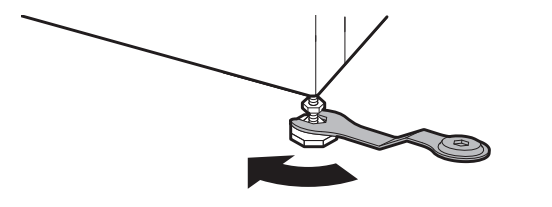
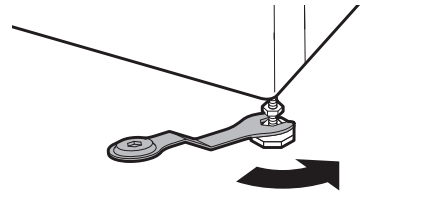
NOTE: Do not install the washing machine on a plinth, stand or elevated surface unless it is manufactured by LG Electronics for use with this model.
2. Check if the appliance is perfectly level using a spirit level (1).
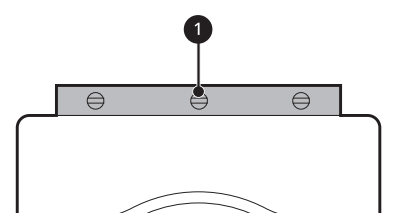
3. Secure the levelling feet with the lock nuts (2) by turning anti-clockwise against the bottom of the appliance.

4. Check if all lock nuts at the bottom of the appliance are secured properly.
NOTE
- Proper placement and levelling of the appliance will ensure long, regular, and reliable operation.
- The appliance must be 100% horizontal and stand firmly in position on a hard flat floor.
- It must not ‘Seesaw’ across corners under the load.
- Do not let the feet of the appliance get wet. Failure to do so may cause vibration or noise.
Using Anti-Slip Sheets
This feature may vary depending on the model purchased.
If you install the appliance on a slippery surface, it may move because of excessive vibration. Incorrect levelling may cause malfunction through noise and vibration. If this occurs, install the anti-slip sheets under the levelling feet and adjust the level.
1. Clean the floor to attach the anti-slip sheets.
Use a dry rag to remove and clean foreign objects and moisture. If moisture remains, the anti-slip sheets may slip.
2. Adjust the level after placing the appliance in the installation area.
3. Place the adhesive side a of the anti- slip sheets on the floor.
- The most effective way is to install the anti-slip sheets under the front feet. If it is difficult to place the sheets under the front feet of the appliance, attach them under the rear feet.
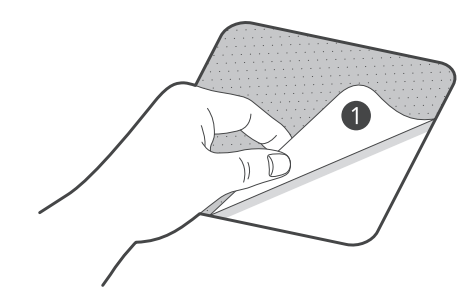
4. Put the appliance on the anti-slip sheets.
- Do not attach the adhesive side a of anti-slip sheets to the feet of the appliance.
NOTE: Additional anti-slip sheets are available at LG Electronics service centre.
Connecting the Water Supply Hose
Checking the Rubber Seal
Two rubber seals (1) are supplied with the water supply hose. They are used to prevent water leaks. Connection to taps is sufficiently tight.
- Do not use mechanical devices such as multi grips to tighten the water supply hose. Ensure that the curved end of the water supply hose is connected to the appliance.
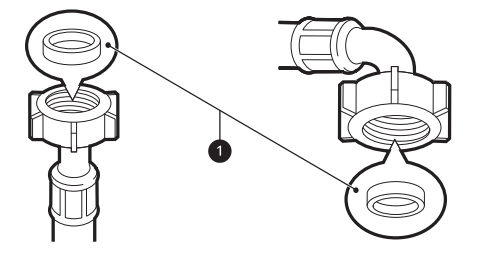
Connecting the Hose to the Water Tap
Connecting Screw-Type Hose to Tap with Thread
Screw the supply hose connector onto the water supply tap. Hand tighten only with the aid of a soft cloth. Do not overtighten the supply hose with any mechanical device.

NOTE: After connecting the water inlet hose to the water tap, turn on the water tap to flush out foreign substances (dirt, sand, sawdust, and etc.) in the water lines. Let the water drain into a bucket, and check the water temperature.
Connecting the Hose to the Appliance
Screw the supply hose to the water inlet valve on the back of the appliance.
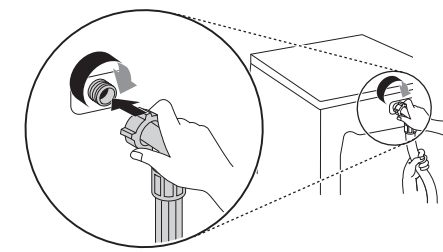
- Do not connect the hose to the hot water supply for models with one water inlet. Connect to the cold water supply only.
NOTE
- After completing connection, if water leaks from the hose, repeat the same steps. Use the most conventional type of tap for the water supply. In case that the tap is square or too big, remove the guide plate before inserting the tap into the adaptor.
- Make sure that the hose should not be kinked or trapped.
Installing the Drain Hose
|
Installing the Drain Hose with the Elbow Bracket The drain hose should not be placed higher than 100 cm above the floor. Water in the appliance may not drain or may drain slowly. Securing the drain hose correctly will protect the floor from damage due to water leakage. |
|
OPERATION
Operation Overview
| 1. Sort clothes by fabric type, soil level, colour and load size as needed. | |
| 2. Open the door and load items into the appliance. | |
|
CAUTION Before closing the door, ensure that all clothes and items are inside the tub and not overhanging on the rubber door seal where they will become caught when the door is closed. Failing to do so will cause damage to the door seal and the clothes. |
|
| 3 Close the door. | |
|
CAUTION Remove items from the flexible door seal gasket to prevent clothing and door seal damage. |
|
|
4. Add cleaning products or detergent and softener. Add the proper amount of detergent to the detergent dispenser. If desired, add bleach or fabric softener to the appropriate areas of the dispenser. |
|
| 5 Press the Power button to turn on the appliance. | |
|
6 Choose the desired cycle. Press the cycle button repeatedly or turn the cycle selector knob until the desired cycle is selected. Now select a wash temperature and spin speed. Pay attention to the fabric care label of your clothes. |
|
|
7. Begin cycle. Press the Start/Pause button to begin the cycle. The appliance will agitate briefly without water to measure the weight of the load. If the Start/Pause button is not pressed within a certain time, the appliance will shut off and all settings will be lost. |
|
|
8. End of cycle. When the cycle is finished, a melody will sound. Immediately remove your clothing from the appliance to reduce wrinkling. |
|
Control Panel
1. Power On/Off Button
Press this button to turn the washing machine on.
2. Programme Knob
- Programmes are available according to the clothes type.
- The lamp will light up to indicate the selected programme.
3. Start/Pause Button
- This button is used to start the wash programme or pause the wash programme.
- If a temporary stop of the wash programme is needed, press this button.
4. Customizing Washing Programme Buttons
Use these buttons to adjust the water temperature or spin speed settings for the selected programme.
- The current settings are shown in the display.
- Press the button for that option to select other settings.
5. Extra Options and Functions
To use the extra functions, press and hold the corresponding button for 3 seconds. The corresponding symbol lights up in the display.
This allows you to select an additional programmes and will light when selected. *Child Lock
Use this option to disable the controls. This function can prevent children from changing cycles or operating the appliance.
*Tub Clean
This is a special function to help clean the inside of the appliance by soaking, washing, rinsing and spinning.
6. Display
The display shows the settings, estimated remaining time, options, and status messages. When the appliance is turned on, the default settings in the display will illuminate.
While the load weight is sensed automatically, the display on the control panel blinks.
Time and Status Display
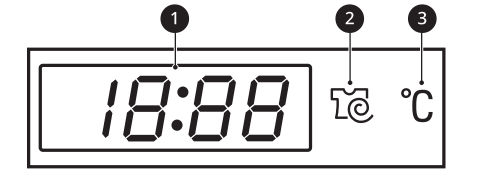
1. Estimated Time Remaining
- When a washing programme is selected, the default time for that programme is displayed. This time will change as options are selected.
- If the display shows --- , then the time will be displayed after the load sensing has detected the load size. This is normal.
- The time shown is only an estimate. This time is based on normal operating conditions. Several external factors (load weight, room temperature, incoming water temperature, etc.) can affect the actual time.
2. lights up when the Spin button is pressed.
3. °C lights up when the Temp. button is pressed.
Preparing the Wash Load
Sorting the Clothes
- For best washing results, sort your clothes according to the care label stating fabric type and washing temperature. Adjust the spin speed or spin intensity in accordance with the fabric type.
- Soil level (Heavy, Normal, Light):
- Separate clothes according to soil level. If possible, do not wash heavily soiled items with lightly soiled ones.
- Colour (White, Lights, Darks): Wash dark or dyed clothes separately from whites or light colours. Mixing dyed clothes with light clothes can result in dye transfer or discolouration of lighter clothes.
- Lint (Lint producers, Collectors): Wash separately lint producing fabrics from lint collecting fabrics. Lint producers can result in pilling and linting on the lint collectors.
Checking the Clothes Care Label
The symbols tell you about the fabric content of your garment and how it should be washed.
NOTE
The dashes under the symbol give you information about the type of fabric and the maximum allowance of mechanical stress.
Checking the Clothes before Loading
- Combine large and small items in a load. Load large items first.
- Large items should not be more than half of the total wash load. Do not wash single items. This may cause an unbalanced load. Add one or two similar items.
- Check all pockets to make sure that they are empty. Items such as nails, hair clips, matches, pens, coins and keys can damage both your appliance and clothes.
- Wash delicates (stockings, underwired bras) in a wash net.
- Close zippers, hooks and strings to make sure that these items do not snag on other clothes.
- Pre-treat dirt and stains by brushing a small amount of detergent dissolved water onto stains to help lift dirt.
Adding Detergents and Softeners
Detergent Dosage
- Detergent should be used according to the instruction of the detergent manufacturer and selected according to type, colour, soiling of the fabric and the washing temperature. Use only detergents that are suitable for Drum front load) type washers.
- If too many suds occur, reduce the detergent amount.
- If too much detergent is used, too many suds can occur and this will result in poor washing results or cause heavy load to the motor.
- If you wish to use liquid detergent, follow the guidelines provided by the detergent manufacturer.
- You can pour liquid detergent directly into the main detergent drawer if you are starting the wash cycle immediately.
- Do not use liquid detergent if you are using the Delay End function, or if you have selected Pre Wash option, as the liquid will dispense immediately and may harden in the drawer or the tub.
- Detergent usage may need to be adjusted for water temperature, water hardness, size and soil level of the load. For best results, avoid overdosing the detergent. Failing to do so will cause oversudsing.
- Refer to the label of the clothes, before adding the detergent and choosing the water temperature.
- Use only suitable detergents for the respective type of clothing:
- Liquid detergent is often designed for special applications, e.g. for coloured fabric, wool, delicate or dark clothes.
- Powdered detergent is suitable for all types of fabric.
- For better washing results of white and pale garments, use powdered detergent with bleach.
- Detergent is flushed from the dispenser at the beginning of the wash cycle.
NOTE
- Do not let the detergent harden. Doing so may lead to blockages, poor rinse performance or odour.
- Full load: According to manufacturer’s recommendation.
- Part load: 1/2 of the normal amount.
- Minimum load: 1/3 of full load.
Using the Dispenser
1 Open the dispenser drawer.
2. Add the detergent and softener into the appropriate compartments.
|
|
1 Main wash detergent compartment |
| 2 Pre-wash detergent compartment | |
| 3 Liquid fabric softener compartment |
3. Gently close the detergent dispenser drawer before starting the cycle.
- Slamming the drawer closed may result in the detergent overflowing into another compartment or dispensing into the drum earlier than programmed.
- Be careful not to get a hand caught in the drawer while closing.
- It is normal for a small amount of water to remain in the dispenser compartments at the end of the cycle.
Fabric Softener Compartment
This compartment holds liquid fabric softener, which is automatically dispensed during the final rinse cycle.
- Either powdered or liquid fabric softener may be used.
- Pour fabric softer to the maximum fill line. Pouring excessive fabric softener over the maximum fill line can cause it to dispense too early, which may stain the clothes.
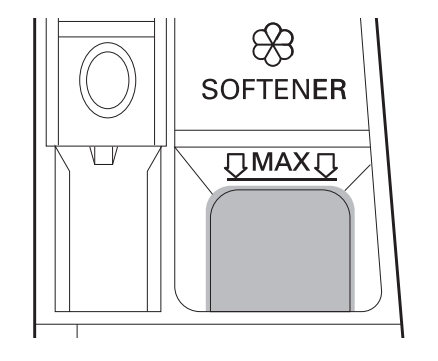
NOTE
- Do not pour fabric softener directly onto the clothes in the wash drum, doing so will cause dark staining on the clothes that will be difficult to remove.
- Do not leave the fabric softener in the detergent drawer for more than 1 day.
- Fabric softener may harden. Softener may remain in the dispenser if it is too thick. The softener should be diluted if the consistency is too thick so that it can flow easily.
- Do not open the drawer when water is being supplied during the wash.
- Solvents (benzene, etc.) must never be used.
Programme Table
Washing Programme
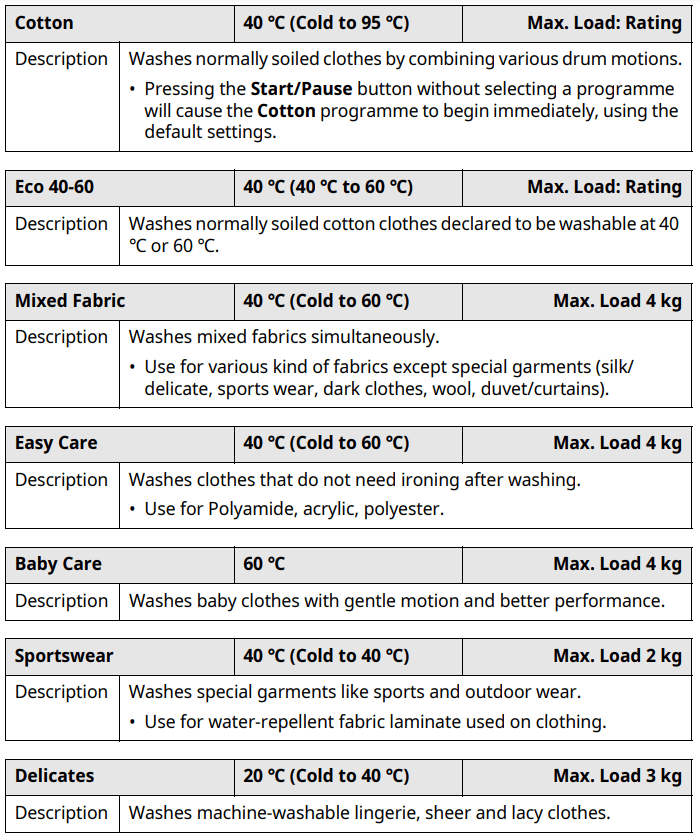
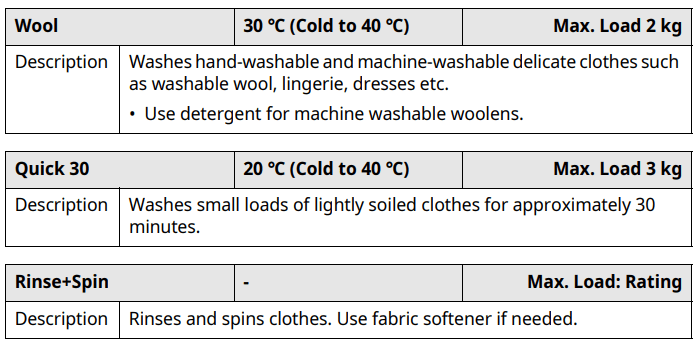
NOTE
• Select the appropriate water temperature for chosen wash programme. Always
follow garment manufacturer’s care label or instructions when washing to avoid
damage to clothes.
• Select the proper wash temperature and spin speed for the desired programmes.
• Actual water temperature may differ from the declared cycle temperature.
See other models: F4V308WNW F4V309WNW F4V309WNE F4V309SNE F4V309WSE
• Neutral detergent is recommended.
SMART FUNCTIONS
Smart Diagnosis
This feature is only available on models with the c or d logo.
Use this feature to help you diagnose and solve problems with your appliance.
NOTE
- For reasons not attributable to LGE’s negligence, the service may not operate due to external factors such as, but not limited to, Wi-Fi unavailability, Wi-Fi disconnection, local app store policy, or app unavailability.
- The feature may be subject to change without prior notice and may have a different form depending on where you are located.
Using Audible Diagnosis to Diagnose Issues
Follow the instructions below to use the audible diagnosis method.
- Launch the LG ThinQ application and select the Smart Diagnosis feature in the menu. Follow the instructions for audible diagnosis provided in the LG ThinQ application.
1. Press the Power button to turn on the appliance.
- Do not press any other buttons.
2. Place the mouthpiece of your smartphone close as below

3. Press and hold the Temp. button for seconds or longer while holding the smartphone mouthpiece to the logo until the data transfer is complete.
- Keep the smartphone in place until the data transfer has finished. Time remaining for data transfer is displayed.
4. After the data transfer is complete, the diagnosis will be displayed in the application.
NOTE
For best results, do not move the smartphone while the tones are being transmitted.
MAINTENANCE
Cleaning After Every Wash
Always remove items from the washing machine as soon as the cycle is complete. Leaving damp items in the washing machine can cause wrinkling, colour transfer, and odour.
- After the wash cycle is finished, wipe the door and door seal to remove any moisture.
- Leave the door slightly open to dry the drum.
- Wipe the appliance with a dry cloth to remove any moisture.
Cleaning the Exterior
Exterior
- Immediately wipe off any spills.
- Wipe with a damp cloth and then again with a dry cloth ensuring there is no moisture in cabinet joints or crevices.
- Do not press on the surface or the display with sharp objects.
Door
- Wash with a damp cloth on the outside and inside and then dry with a soft cloth.
WARNING
Do not attempt to separate any panels or disassemble the appliance. Do not apply any sharp objects to the control panel in order to operate the appliance.
Cleaning the Appliance Periodically & Performing an Emergency Water
Tub Clean
This is a special function to help clean the inside of the appliance by soaking, washing, rinsing and spinning.
Run this function once a month (or more often if needed) to reduce build-up of detergent and softener and other residue.
- If there is a bad smell or mildew inside the appliance, run this function once a week for 3 weeks in addition to the regularly prompted intervals.
1. Remove any clothing or items from the appliance and close the door.
2. Open the dispenser drawer and add anti limescale powder to the main wash compartment.
- Tablets can be placed directly into the drum as an alternative to powder.
3. Close the dispenser drawer slowly.
4. Turn on the power, and then press the Delay End and Pre Wash buttons at the same time for 3 seconds.
5. Press the Start/Pause button to start.
6. Leave the door open to dry the inside of the appliance completely.
- When the inside of the appliance is not dried completely, it may cause a bad smell or mildew.
WARNING
Leave the door open to dry inside of the appliance only if the children are supervised at home.
Cleaning the Water Inlet Filter
The water inlet filter collects lime or any sediment that may be in water that is supplied to the appliance. Clean the inlet filter every six months or so, or more often if the water is very hard or contains traces of limescale.
- Turn off the water supply taps to the appliance if the appliance is to be left for a certain period of time (e.g. holiday), especially if there is no floor drain (gully) in the immediate vicinity.
- IE error message will be displayed on the control panel when the water is not entering the detergent drawer.
1. Turn off the power and the water tap and then unscrew the water inlet hose.

2. Remove the water inlet filter with small pliers and then clean the filter using a medium bristle tooth brush.
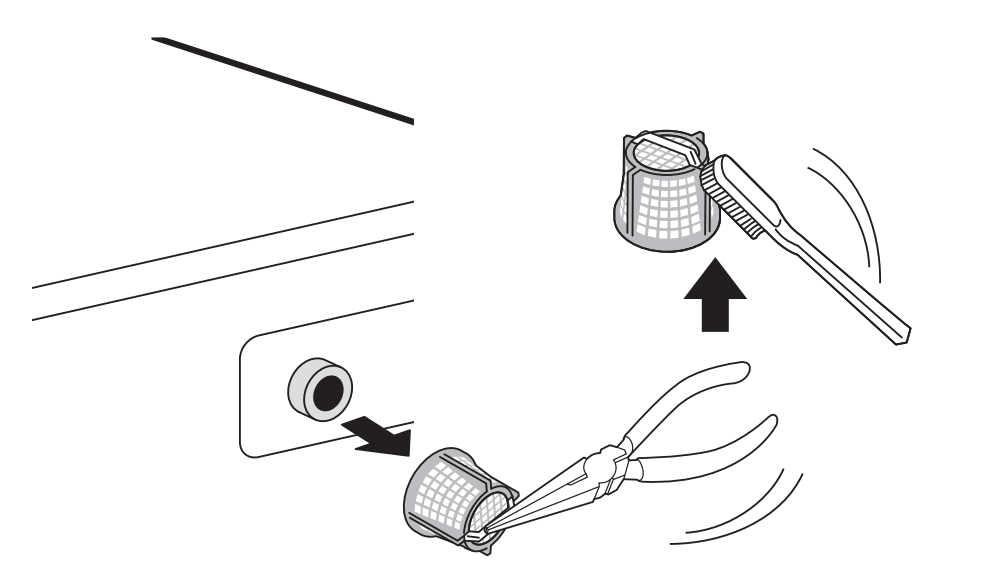
Cleaning the Drain Pump Filter and Performing an Emergency Water Evacuation
The drain filter collects threads and small objects that may have been accidentally left in the clothes. Make sure that the filter is clean every six months to ensure smooth running of your appliance.
Allow the water to cool before cleaning the drain pump filter. Open the door in an emergency or perform an emergency water evacuation.
1. Unplug the appliance.
2. Open the cover cap and pull out the drain tube.
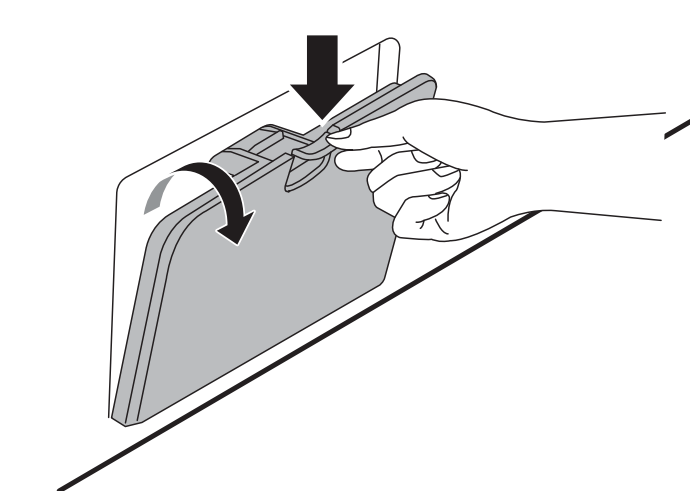
3. Remove the drain plug from the drain tube first (1), and then drain the water. Then slowly unscrew the drain pump filter (2) to drain the remaining water and then proceed to remove any debris or objects from the filter.

4. After cleaning the drain pump filter, carefully reinsert the filter and screw the drain cap back in clockwise carefully to avoid cross-threading and leakage. Reinsert the plug back into the drain tube and place the tube into its holder.
5. Close the cover cap.
Cleaning the Dispenser Drawer
Detergent and fabric softener can build up in the dispenser drawer. Liquid detergents can remain under the dispenser drawer and not dispense completely. Remove the drawer and inserts and check for build-up of cleaning products once or twice a month.
1. Remove the detergent dispenser drawer by pulling the drawer straight out until the drawer stops.
- Then gently pull the drawer outward while pressing hard the disengage button.
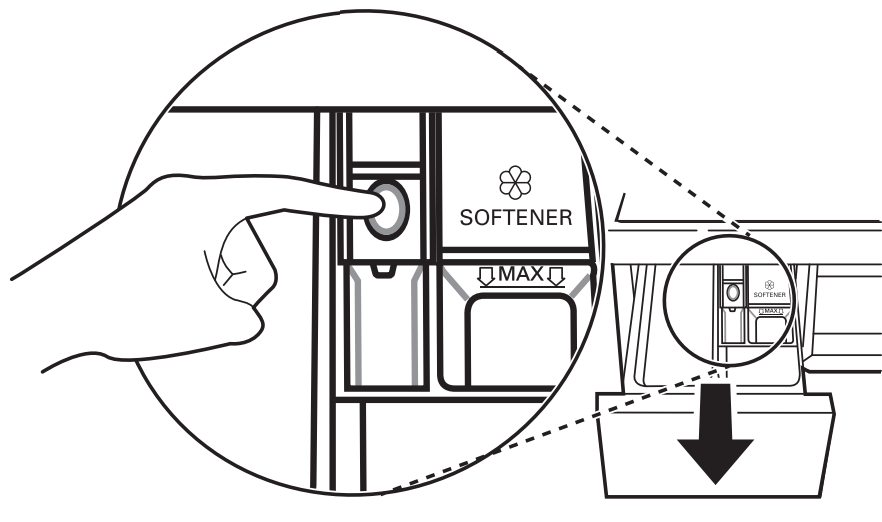
2. Remove the build-up of detergent and softener.
- Rinse the drawer and the components of the drawer with warm water to remove the build-up from detergent and softener. Use only water to clean the dispenser drawer. Dry the drawer and the components of the drawer with a soft cloth or towel.
3. To clean the drawer opening, use a cloth or small, non-metal brush to clean the recess.
- Remove all residue from the upper and lower parts of the recess.
4. Wipe any moisture off the recess with a soft cloth or towel.
5. Reassemble the components of the drawer to the proper compartments and insert the drawer.
TROUBLESHOOTING
|
Symptoms |
Possible Cause & Solution |
|---|---|
 INLET ERROR INLET ERROR |
Water supply is not adequate in that location. Water does not enter appliance or it enters slowly. • Check another tap in the house. Water supply tap is not completely open. Water does not enter the appliance or it enters slowly. • Open fully tap. Water supply hose(s) are kinked. • Straighten hose or reinstall the water inlet hose The filter of the supply hose(s) are clogged. • Check and clean the inlet valve filter after turning off the tap and removing the hose connections to the washing machine. |
 UNBALANCE UNBALANCEERROR |
The appliance has a system which detects and correctsthe unbalance of the appliance. • The clothes may be too wet at the end of the cycle, rearrange the load to allow proper spinning. Close the door and press Start/Pause button. It may take a few moments before the appliance begins to spin. The door must be locked before spin can be achieved. |
| Load is too small. This system may stop spinning or even interrupt the spin cycle altogether if individual heavy articles (e.g. bath mat, bath robe, etc.) are loaded. • Add 1 or 2 similar items or smaller articles of clothes to help balance the load. Close the door and press Start/Pause button. It may take a few moments before the appliance begins to spin. The door must be locked before spin can be achieved. |
|
 WATER OUTLET WATER OUTLETERROR |
Drain hose is kinked or clogged. Water in the appliance does not drain or drains slowly. • Clean and straighten the drain hose. |
| The drain filter is clogged. • Check and clean the drain filter. |
|
|
DOOR ERROR |
Door sensor malfunctions. • Please call LG service centre. You can find your local LG service centre phone number in the warranty card. |
|
CONTROL ERROR |
Over load in motor. • Let the appliance wait for 30 minutes until the motor is cooled down and then, restart the cycle. |
|
OVERFLOW ERROR |
Water overfills due to a possible faulty water valve. • Close the water tap. Unplug the power plug. Call for service. |
|
VIBRATION |
Vibration sensor malfunctions. • Call for service. |
|
FROZEN FAILURE |
Is supply/drain hose or drain pump frozen? • Supply warm water into the drum in order to unfreeze the drain hose and the drain pump. Cover the supply hose with wet and warm towel. |
|
WATER LEAKAGE |
Water leaks. • Call for service. |
|
POWER FAILURE |
The appliance experienced a mains power failure. • Restart the cycle. |
Noises
| Rattling and clanking noise |
Foreign objects, such as keys, coins, or safety pins may be in the drum. • Stop the appliance, check the drum for foreign objects. If the noise continues after the appliance is restarted, call for service. |
| Thumping sound | Heavy clothes may produce a thumping sound. This is usually normal. • If the sound continues, the appliance is probably out of balance. Stop and redistribute the clothes. |
| The clothes may be out of balance. • Pause the programme and redistribute the clothes after the door unlocks. |
|
| Vibrating noise | Package materials are not removed. • Remove package materials. |
| The clothes may be unevenly distributed in the drum. • Pause the programme and redistribute the clothes after the door unlocks. |
|
| Not all levelling feet are resting firmly and evenly on the floor. | |
| Floor not rigid enough. • Check if the floor is sold and does not flex. |
Operation
| Appliance does not operate. |
Control panel has powered off due to inactivity. Controls are not set properly. |
| Buttons may not function properly. |
The Child Lock option is activated. • Deactivate the Child Lock option if necessary. |
| Door does not open. |
The door cannot be opened for safety reasons once the appliance starts. This is normal. You can safely open the door after H turns off. |
| Appliance is not filling properly. |
Inlet filter clogged.
|
| Appliance does not drain water. |
Kinked drain hose.
|
| Detergent is not dispensed incompletely or not dispensed at all. |
|
| Cycle time is longer than usual. |
|
| Cycle end is delayed |
Unbalance is detected or suds removing programme is on. • This is normal. The time remaining shown on the display is only an estimated duration. Actual time may vary. |
| Poor stain removal |
Previously set stains. • Articles that have been previously washed may have stains which have been set. These stains may be difficult to remove and may require hand washing or pre-treating to aid in stain removal. |
| Staining |
Bleach or softener is dispensed too soon.
|

